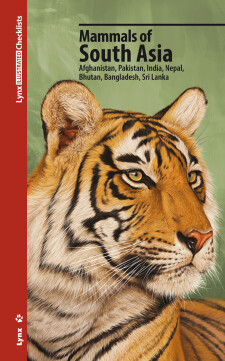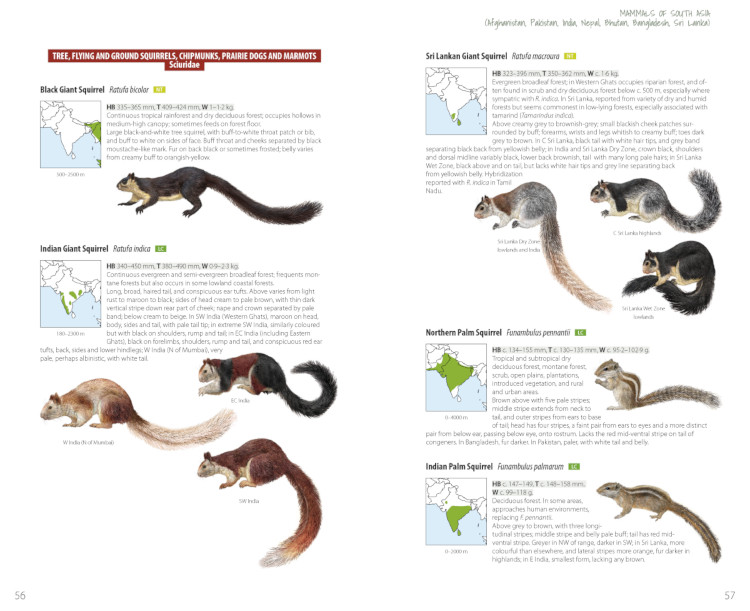Reviewed by Frank Lambert on January 12th, 2022.
This illustrated checklist, Mammals of South Asia, covers Afghanistan, Pakistan, India, Nepal, Bhutan, Bangladesh, and Sri Lanka, as well as the Andaman, Nicobar, and Laccadive islands (to the west of South India). South Asia is very rich in mammals, as this book shows, but despite depicting 540 species of mammal in 56 families, it is a remarkably slim book of 173 pages, easy to pack and carry even if you already have a field guide to birds with you. This is the second guide in the Lynx Illustrated Checklists series, created using the copious information, artwork, and maps assembled for the widely acclaimed Handbook of the Mammals of the World series and the excellent two-volume Illustrated Checklist of the Mammals of the World.
The checklist follows the taxonomy of Mammals of the World, briefly describing all the species recorded within the region and providing a range map and 1-2 painted illustrations for each species. Variation relating to subspecies or location is only depicted for a small number of species, these mainly being some of the primates (e.g. Grey Slender Loris, Bonnet Macaque, Purple-faced and Capped Langur), squirrels (e.g. Indian Giant Squirrel), cetaceans (e.g. Common Bottlenose Dolphin), ungulates Barasingha, Blackbuck, Markhor), and Leopard. Illustrations of the tail shape of whales would have been useful to include, since this is something that can sometimes be seen, and is diagnostic in some cases.
The five-page introduction includes a topographical map of the region covered, along with surrounding countries, although unfortunately there is no key to the altitudes that are coloured, or any scale. Also included is a two-page table that names some key mammals occurring in 36 National Parks and other conservation areas and serves as a useful guide if planning a trip to see particular species.
The checklist itself comprises 152 pages, with mostly 3-4 species per page. Alongside the illustrations there is a short description of habitats used by the taxon, a description, Red List status, and range map. The Checklist ends with the very short list of references and a comprehensive index. In contrast to the bird field guides published by Lynx, no use has been made of the inside covers, perhaps a missed opportunity. A code is provided that can be used to download a complete checklist of all the mammals recorded for each country, which many users will find useful.
Strictly speaking, this is not a field guide, although it will help identify almost all the larger mammals one might encounter, provided good views or photographs are obtained. For smaller species, which form the bulk of the animals in the checklist, some can be tentatively identified using the range maps (e.g. pikas), but for most this will never prove entirely convincing. Range maps are based on recent information, so are as accurate as possible given the constraints of a small guide such as this. One error noted is that the map for Hog Deer does not show its occurrence in the southwestern coastal belt of Sri Lanka.
Along with many rodents, the shrews and bats (which take up 48 pages, almost a third of the checklist), cannot be safely identified using this book. That would also be true of any field guide, however, unless it was copiously and accurately illustrated. Identifying many rodents, as well as most bats and shrews, requires good photographs or details of the noseleaf, teeth, etc. that can only be documented in the hand, although distribution and habitat may help. It should be noted, however, that the distribution of many of these smaller, lesser-known mammals is still poorly documented, so range maps are unlikely to show the true extent of their distribution.
One thing that is missing from the book is a glossary of terms. The descriptions of bats include many words for specific parts of the animal that users may need to look up, such as patagium, tragus, axilla, and calcar. Although not intended as a field guide, it is likely to be used as one in practice more than as a simple checklist, so it would have been helpful to have included a pictorial guide to the named parts of bats in the introduction.
Overall, Mammals of South Asia is an excellent book, and extremely useful for any trips to the Indian Subcontinent. South Asia sorely needs a high-quality mammal field guide, but for now this is a useful stopgap. Indeed, as mentioned above, it can be used to identify the great majority of the larger mammals encountered, if good views are obtained. Hopefully Lynx is already working on a field guide, but in the meantime I would highly recommend taking this slim volume, weighing only 400g (less than 1lb), on any birding or wildlife-watching trips in the countries that it covers.
– Reviewed by Frank Lambert





Comment